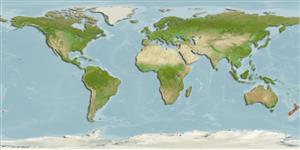分类 / Names
俗名 | 同种异名 | Catalog of Fishes(属, 种) | ITIS | CoL | WoRMS | Cloffa
Teleostei >
Gobiesociformes (Clingfishes) >
Gobiesocidae (Clingfishes and singleslits) > Trachelochisminae
Etymology: Trachelochismus: Greek, trachelos = neck + Greek, schismos, -ou = cut (Ref. 45335).
More on author: Forster.
Environment: milieu / climate zone / depth range / distribution range
生态学
海洋 居于水底的; 深度上下限 0 - 70 m (Ref. 116173). 溫帶
Southwest Pacific: endemic to New Zealand.
西南太平洋: 紐西蘭的特有種。
大小 / 重量 / 年龄
Maturity: Lm ? range ? - ? cm
Max length : 10.0 cm TL 雄鱼/尚未辨别雌雄; (Ref. 9003)
简单描述
检索表 | 型态特徵 | 形态测量图
背棘 (总数) : 0; 背的软条 (总数) : 7 - 9; 臀棘: 0; 臀鳍软条: 5 - 7. Pink to red or green dorsally, possibly with longitudinal bands of brown, or spotted brown and yellow. Occasionally with patches of pink over the dorsal surface. Pale creamy white ventrally. Distinguished from other clingfishes by the broad, bluntly pointed head, a thick, fleshy upper lip and a longitudinal groove below the eye lined with fleshy lobes. The sucking disc lacks flattened papillae across the anterior margin.
粉红色到红色或绿色的背面, 可能有褐色的纵向条纹 , 或有斑点的褐色与黄色。 偶然地以粉红背部表面之上的区块。 灰白的乳脂色的腹侧白色的。 与宽又顿尖头部的其他喉盘鱼科鱼类区分了,线的一个厚又肉质的上嘴唇与一个纵向的凹槽眼睛下面有肉质的叶。 吸盘缺乏横过平的了乳突前缘。
Common in rock pools at mid to low tide and in subtidal areas. Usually found clinging under rocks of exposed areas. Feeds on small mollusks, polychaete worms, amphipods, and other crustaceans.
常见于岩石区潮池在对低潮之中与在亚潮带区中。 通常发现黏在裸露区域的岩石下。 吃小的软件动物,多毛类的蠕虫,片脚类动物与其他的甲壳动物。
Life cycle and mating behavior
成熟度 | 繁殖 | 产卵场 | 卵 | 孕卵数 | 仔鱼
西南太平洋: 紐西蘭的特有種。
Paulin, C. and C. Roberts, 1992. The rockpool fishes of New Zealand (Te ika aaria o Aotearoa). Museum of New Zealand (Te Papa Tongarewa). 177 p. (Ref. 9003)
世界自然保护联盟红皮书 (Ref. 130435: Version 2024-1)
人类利用
工具
特别资料
下载 XML
网络资源
Estimates based on models
Preferred temperature (Ref.
123201): 13.8 - 19.4, mean 16.5 °C (based on 106 cells).
Phylogenetic diversity index (Ref.
82804): PD
50 = 0.7500 [Uniqueness, from 0.5 = low to 2.0 = high].
Bayesian length-weight: a=0.00457 (0.00179 - 0.01169), b=3.12 (2.89 - 3.35), in cm total length, based on LWR estimates for this (Sub)family-body shape (Ref.
93245).
营养阶层 (Ref.
69278): 3.4 ±0.46 se; based on food items.
回复力 (Ref.
120179): 中等的, 族群倍增时间最少 1.4 - 4.4年 (Preliminary K or Fecundity.).
Fishing Vulnerability (Ref.
59153): Low vulnerability (10 of 100).
